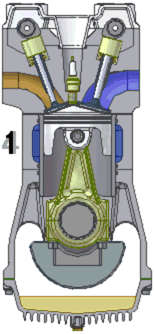AY Honors/Automobile Mechanics/Answer Key
Skill Level 2
1. Properly start an automobile or light truck engine with an automatic transmission and one with a standard transmission. Explain why it is necessary for the engine to have the proper oil, water, fuel, and battery pressures and levels for proper engine operation.
Starting an Automatic
To start a vehicle with an automatic transmission, sit in the driver's seat and make sure the vehicle is in Park. Insert the key in the ignition and turn it clockwise as far as it will go. The engine should crank. Do not depress the gas pedal. As soon as the engine starts, release the key. To turn it off, turn the key counter-clockwise.
Starting a Manual
To start a vehicle with a manual transmission, sit in the driver's seat and push on the clutch pedal. Make sure the parking brake has been applied. Inexperienced drivers should also shift the vehicle into neutral so that if the foot slips off the clutch after the engine starts, the car does not move. Insert the key in the ignition and turn it clockwise as far as it will go. The engine should crank. Do not depress the gas pedal, but leave the clutch pedal depressed. As soon as the engine starts, release the key. To turn it off, turn the key counter-clockwise.
Importance of Proper Pressures and Levels
Oil keeps the engine lubricated and reduces friction between the moving parts of the engine. Friction causes heat, so if there is insufficient oil pressure in the engine, it will quickly overheat. Running an engine without oil for any amount of time will damage it, and doing so for an extended period will destroy it.
Water circulates through the engine to cool it. Running an engine too hot will dmage it.
Fuel is what makes the engine go. If the vehicle has insufficient fuel pressure, the fuel will not flow into the combustion chamber at the proper rate.
The Battery provides energy to run the engine's starter. If the battery's volatage level is low, it will not be able to turn the starter.
2. Explain the principles of four- and two-cycle engines and the difference between gasoline and diesel engines. Explain the major differences between carburetor fuel systems and fuel-injection systems.
Four-cycle Engine
A four-cycle engine is so named because it makes four strokes to generate power. These strokes are as follows:
- Intake Stroke: During this stroke, the piston draws a mixture of fuel and air into the cylinder. The fuel and air enters through an intake valve which opens during this stroke.
- Compression Stroke: Once the fuel and air have been drawn into the cylinder, the intake valve close and the piston returns towards the engine's head. This compresses the fuel.
- Power Stroke: When the piston reaches the top of the cylinder, the spark plug fires, igniting the compressed fuel and air mixture and causing an explosion. This explosion causes the gases to expand which powers the piston downwards again. This is where the engines power (and noise!) comes from.
- Exhaust Stroke: When the piston reaches the bottom of the cylinder, the exhaust valve opens, and as the piston returns to the top of the cylinder again, the exhaust gases are pushed out. When the clylinder reaches the top again, the four cycles are ready to repeat.
Two-cycle Engine
This link has an animation of a two-cycle engine in action. (We need to come up with our own animation here that can be freely distributed).
Power and Exhaust Stroke: In a two-cycle engine, the spark plug fires every time the piston reaches the top of the cylinder. This is the beginning of the power and exhaust cycle. As in the four cycle engine, the spark plug firing causes a compressed air/fuel mixture in the cylinder to explode, and the expanding gases drive the piston downward. As the cylinder goes down, it compresses another air/fuel mixture inside the crankcase - not inside the cylinder as in the four-stroke engine. The crankcase is the area beneath the piston, and the cylinder is the area above the piston. When the piston nears the bottom of this stroke, it uncovers an exhaust outlet and it also uncovers a passage between the crankcase and the cylinder. The compressed air-fuel mixture in the crankcase then rushes through this passage-way into the cylinder, forcing the exhaust gases out of the cylinder though the exhaust outlet. Some of the air/fuel mixture is also forced out the exhaust outlet, and this unfortunately decreases the engine's fuel efficiency and increases its pollution output. The piston's head is shaped in such a way as to minimize this waste, but it does not entirely eliminate it.
Intake and Compression Stroke: After the piston reaches the bottom of the stroke, it begins travelling upwards again, compressing the air/fuel mixture that rushed into the cylinder from the crankcase during the previous stroke, and simulataneously drawing more air and fuel into the crankcase. By the time the piston reaches the top of the cylinder, the air/fuel mixture is very highly compressed - much more compressed than it was in the crankcase. It is at this point in the cycle that the intake valve closes and the spark plug fires.
Because the crankcase is opened to the cylinder during its operation, oil in the crankcase makes its way into the cylinder where it is compressed and combusted along with the fuel. If this situation were ignored, the engine would soon burn up all its oil, leaving itself unlubricated. The engine would soon get so hot that its parts would fuse together and destroy itself. This is addressed by adding oil to the fuel (often one part oil to sixteen parts fuel). Thus the engine's oil supply is refreshed on every stroke of the piston. This unfortunately increases the pollution levels generated by two-stroke engines.

